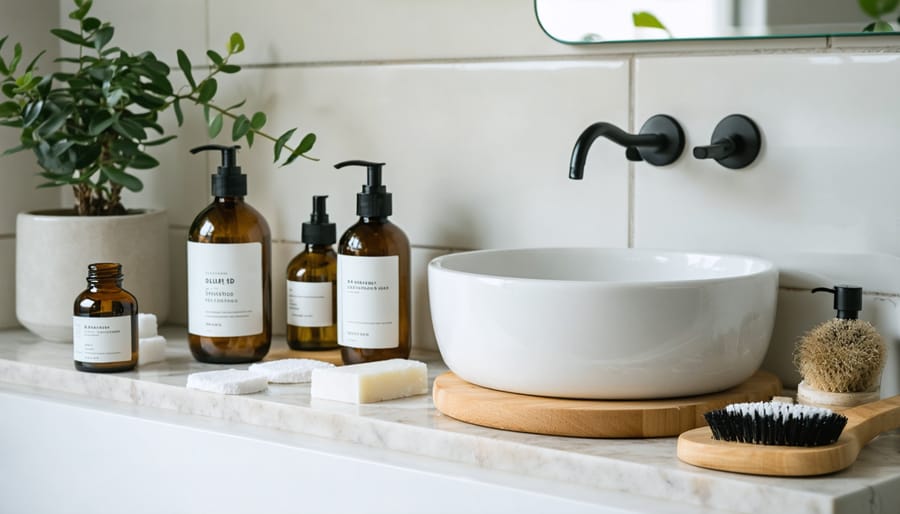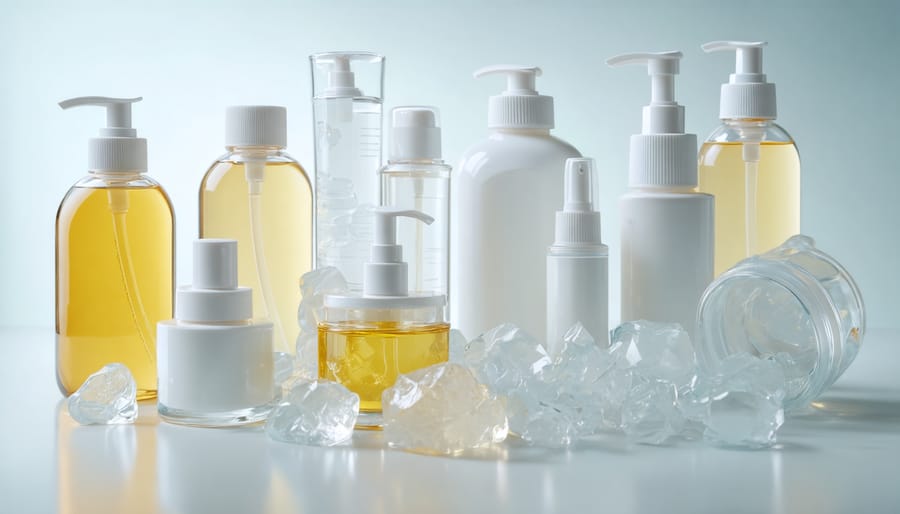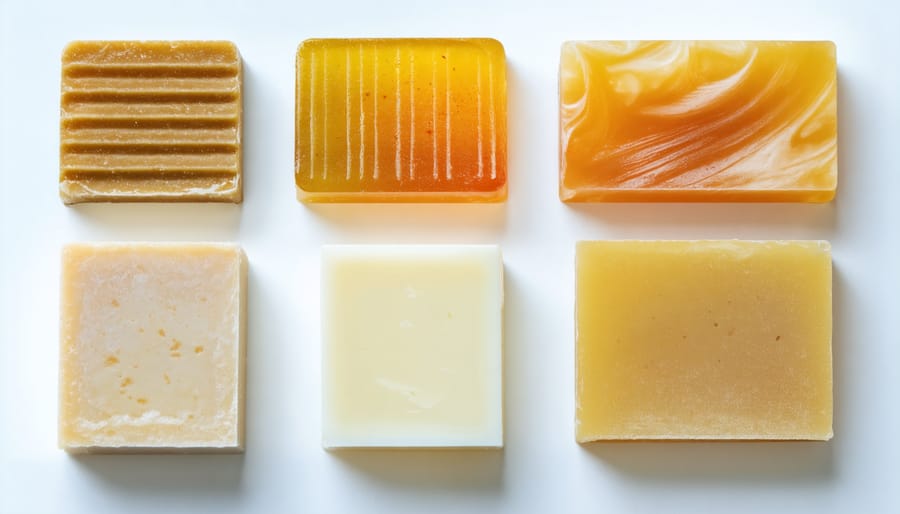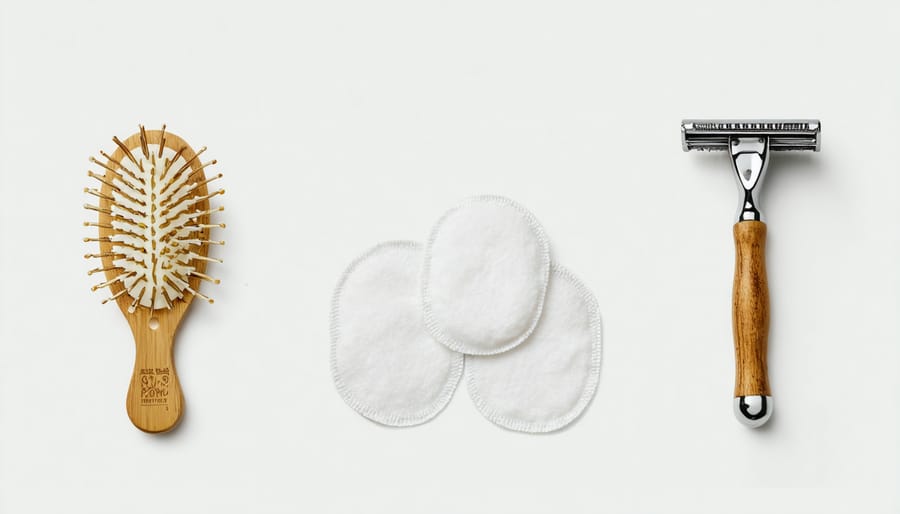
Transform your bathroom into a zero-waste sanctuary by replacing traditional toiletries with natural beauty products that leave no trace on our planet. Swap plastic bottles for package-free shampoo bars that last three times longer than liquid alternatives. Create your own moisturizer using organic coconut oil and essential oils stored in reusable glass containers. Switch to reusable bamboo makeup remover pads and washable cotton rounds that eliminate daily waste while saving money over time.
The beauty industry generates over 120 billion units of packaging annually, but your daily routine doesn’t have to contribute to this staggering statistic. By embracing zero-waste alternatives, you’re not just simplifying your beauty regimen – you’re participating in a movement that proves effective skincare and environmental consciousness can coexist beautifully. Whether you’re a seasoned eco-warrior or just beginning your sustainable journey, transitioning to zero-waste beauty products offers an empowering way to care for both your skin and the planet.
Think of your zero-waste beauty routine as a form of mindful self-care that extends beyond personal benefits to create lasting positive impact. Each plastic-free choice ripples outward, inspiring others and contributing to a cleaner, more sustainable future for all.
Why Traditional Beauty Products Are an Environmental Concern
The Plastic Problem in Beauty
Like many of you, I used to have a bathroom counter filled with countless plastic bottles and containers. It wasn’t until I learned about the environmental impact of beauty products that I realized the scale of our plastic problem. The beauty industry produces over 120 billion units of packaging annually, with the majority being single-use plastic that ends up in our landfills and oceans.
Here’s what makes this particularly concerning: the average beauty consumer goes through approximately 12 plastic bottles of shampoo, conditioner, and body wash each year. When you factor in makeup containers, moisturizer jars, and various other beauty products, a single person can generate up to 18 pounds of beauty-related plastic waste annually.
Even more troubling is that only 9% of all plastic ever produced has been recycled. The rest either sits in landfills for hundreds of years or makes its way into our oceans, affecting marine life and ecosystem balance. These statistics might feel overwhelming, but they’re also empowering – they show us exactly where we can make meaningful changes in our daily routines.

Hidden Environmental Costs
While zero beauty products may seem like the perfect eco-friendly solution, there are some hidden environmental impacts we should be aware of. I learned this the hard way when I discovered that even products labeled as “natural” or “zero waste” can contain microplastics in unexpected forms. These tiny particles, often listed as polyethylene or nylon-12 on ingredients lists, eventually make their way into our waterways and marine ecosystems.
Beyond microplastics, some common natural ingredients in zero waste beauty products require careful consideration. Essential oils, while wonderful in many ways, often demand intensive farming practices and significant water usage. For example, it takes about 10,000 pounds of rose petals to produce just one pound of rose essential oil.
The good news is that being aware of these hidden costs helps us make better choices. Look for products with transparent ingredient sourcing, opt for items with minimal processing, and consider simple, single-ingredient alternatives when possible. Remember, the goal isn’t perfection but making informed decisions that align with both our beauty needs and environmental values.
Essential Zero Waste Beauty Swaps
Solid Beauty Bars
Remember those colorful plastic bottles lining your shower? Solid beauty bars offer a refreshing alternative that’s both eco-conscious and effective. These package-free wonders are revolutionizing our beauty routines, one bar at a time.
From shampoo and conditioner to facial cleansers and body lotions, solid bars are available in countless varieties to suit every beauty need. They’re typically made with concentrated ingredients, meaning a single bar can last as long as three liquid bottles – talk about getting more bang for your buck!
I was skeptical at first, but after switching to a solid shampoo bar six months ago, I’m completely converted. Not only does my hair feel amazing, but I love knowing I’m not adding more plastic to our oceans.
Look for bars enriched with nourishing ingredients like coconut oil, shea butter, and essential oils. Popular options include charcoal facial bars for deep cleansing, argan oil-infused shampoo bars for shine, and cocoa butter moisturizing bars for intense hydration. Many artisanal makers also offer specialized formulations for different hair and skin types.
Storage tip: Keep your bars dry between uses with a wooden soap dish or bamboo holder. This simple step extends their life and prevents waste, making them even more economical in the long run.

Reusable Tools and Accessories
Making the switch to reusable beauty tools isn’t just better for the planet – it’s often gentler on your skin and your wallet too! I remember being skeptical about giving up my disposable cotton rounds, but now I can’t imagine going back to throwing away dozens of them each week.
Start with the basics: swap cotton rounds for soft, washable bamboo or organic cotton versions. They’re incredibly gentle on sensitive skin and actually hold up better when removing stubborn makeup. Keep a small mesh bag in your bathroom to collect used ones, then toss them in with your regular laundry.
For facial cleansing, consider investing in a set of soft microfiber cloths or muslin washcloths. These provide gentle exfoliation while being infinitely reusable. I’ve had my set for over two years now, and they’re still going strong!
Replace disposable razors with a safety razor – they’re not just aesthetically pleasing but also provide a closer shave. The initial investment might seem steep, but you’ll save money in the long run by only replacing the blades.
Other sustainable swaps include:
– Silicone makeup removing pads
– Wooden hairbrushes with natural bristles
– Metal nail files instead of disposable emery boards
– Reusable silicone sheet masks
– Glass or bamboo spray bottles for DIY products
Remember to clean your reusable tools regularly to maintain hygiene and extend their lifespan. A simple mix of gentle soap and warm water usually does the trick, followed by thorough air-drying.

DIY Beauty Solutions
Creating your own homemade beauty products is easier than you might think! I discovered this when I ran out of face moisturizer one evening and had to get creative with what I had in my kitchen. Here are three of my favorite tried-and-tested recipes that work wonders:
For a gentle facial cleanser, mix 2 tablespoons of honey with 1 tablespoon of coconut oil. This combination removes makeup while nourishing your skin. I love using this on winter evenings when my skin needs extra moisture.
Need a natural exfoliator? Combine 3 tablespoons of used coffee grounds with 2 tablespoons of coconut oil and 1 tablespoon of brown sugar. This scrub not only smooths your skin but also reduces waste by repurposing coffee grounds.
For dry, damaged hair, mash one ripe avocado with 2 tablespoons of olive oil and 1 tablespoon of honey. Apply this mask to damp hair, leave for 20 minutes, then rinse thoroughly. Your hair will thank you!
Remember to always do a patch test before trying new ingredients on your skin, and store your DIY products in clean, airtight containers. Most of these recipes can last up to a week when refrigerated, but it’s best to make small batches fresh when needed.
Building Your Zero Waste Beauty Routine
Starting Small
Starting your zero-waste beauty journey doesn’t have to feel overwhelming. I remember standing in my bathroom, looking at all my plastic bottles and feeling anxious about making the switch. The key is to begin with small, manageable changes that fit naturally into your simple skincare routine.
Begin by using up what you already have – this prevents unnecessary waste and gives you time to research alternatives. As products run out, replace them one at a time with zero-waste options. Start with something easy, like switching your plastic shampoo bottle for a shampoo bar, or replacing disposable cotton rounds with washable alternatives.
Another gentle first step is to audit your current routine. Do you really need every product on your shelf? Many of us can simplify our routines by identifying our essential items. Try keeping a weekly log of which products you actually use – you might be surprised by what you can eliminate.
Consider exploring multi-purpose products, like coconut oil for makeup removal and moisturizing, or aloe vera for both face masks and hair treatments. These natural alternatives often come with minimal packaging and serve multiple functions in your beauty routine.
Remember, the goal isn’t perfection – it’s progress. Even small changes add up to significant impact over time, and you’ll find your confidence growing with each sustainable swap you make.
Shopping Tips
Finding zero waste beauty products has become increasingly accessible, with many options available both online and in physical stores. I’ve discovered that local farmers’ markets and eco-friendly shops often carry handmade soaps, shampoo bars, and natural beauty products with minimal packaging. These venues are great for meeting makers directly and learning about their sustainability practices.
Many established brands now offer refill stations in select locations, where you can bring your own containers to stock up on everything from body wash to facial toners. Popular retailers like Lush and The Body Shop have embraced this concept, making it easier to shop sustainably at familiar stores.
Online marketplaces dedicated to zero waste products have also flourished. Websites like Package Free Shop, Zero Waste Store, and EarthHero specialize in plastic-free beauty alternatives. What I love about these platforms is that they typically provide detailed information about ingredients and packaging materials, helping you make informed choices.
Don’t overlook small batch producers on platforms like Etsy, where many artisans create beautiful zero waste products. Local bulk stores are another hidden gem – while primarily known for food, many now stock beauty essentials like soap nuts, clay masks, and essential oils that you can purchase using your own containers.
Remember to start small and replace items as they run out, rather than overhauling your entire routine at once. This approach makes the transition more manageable and reduces unnecessary waste.
Common Challenges and Solutions
Making the switch to zero waste beauty products isn’t always a smooth journey, and I’ve encountered many of the same challenges you might be facing. Let’s tackle some common concerns and their practical solutions.
One frequent worry is the perceived higher cost of zero waste alternatives. While the initial investment might be higher, these products often last longer and eliminate the need for constant repurchasing. For example, a solid shampoo bar typically lasts 2-3 times longer than a bottle of liquid shampoo, making it more cost-effective in the long run.
Storage and travel can also present challenges. Many of us are used to convenient plastic packaging that’s lightweight and spill-proof. To solve this, invest in reusable containers made from glass, bamboo, or stainless steel. For travel, try using small metal tins or compostable paper containers to store your solid beauty products.
Product effectiveness is another common concern. I remember feeling skeptical about whether natural, package-free products could perform as well as their conventional counterparts. Through experience, I’ve found that many zero waste options work just as effectively – it’s just a matter of finding the right products for your needs and giving your body time to adjust.
Availability can be limited in some areas, making it harder to find zero waste alternatives. Consider shopping online from dedicated zero waste retailers or supporting local bulk stores. You might also explore making simple products at home, like facial scrubs or hair masks, using natural ingredients from your kitchen.
Lastly, the transition period can feel overwhelming. Remember that going zero waste doesn’t have to happen overnight. Start by replacing items as they run out, focusing on one product category at a time. This approach makes the switch more manageable and allows you to learn what works best for your routine.
By addressing these challenges gradually and finding solutions that work for your lifestyle, you’ll be able to create a sustainable beauty routine that aligns with both your values and your needs.
Embarking on a zero waste beauty journey might seem daunting at first, but remember that every small step counts toward a more sustainable future. As we’ve explored throughout this article, transitioning to zero waste beauty products not only helps protect our environment but can also simplify our routines and save money in the long run.
Start by implementing one change at a time – perhaps switching to a shampoo bar or making your own face scrub from kitchen ingredients. You’ll likely find that these alternatives work just as well, if not better, than their packaged counterparts. I remember feeling overwhelmed when I first started, but after six months, my bathroom counter was nearly plastic-free, and I felt incredibly proud of the progress.
Remember, zero waste beauty isn’t about perfection; it’s about making conscious choices that align with both your values and your lifestyle. Join local zero waste communities, share your experiences, and learn from others who are on the same journey. You might be surprised by how many creative solutions you discover along the way.
Whether you’re ready to dive in completely or prefer to take baby steps, your efforts matter. Every refill bottle, every reusable cotton pad, and every plastic container avoided makes a difference. So why not start today? Your skin – and our planet – will thank you for it.



